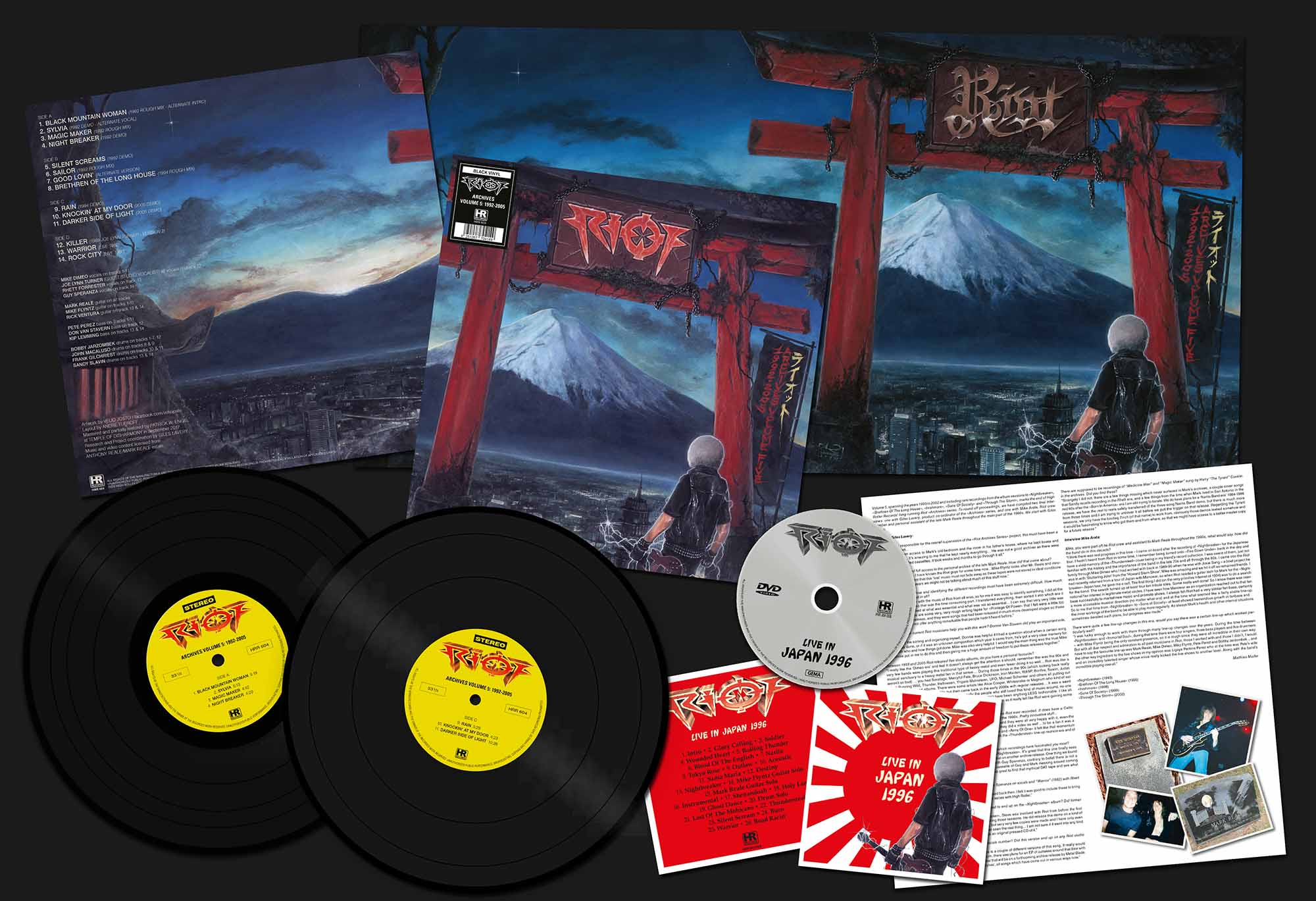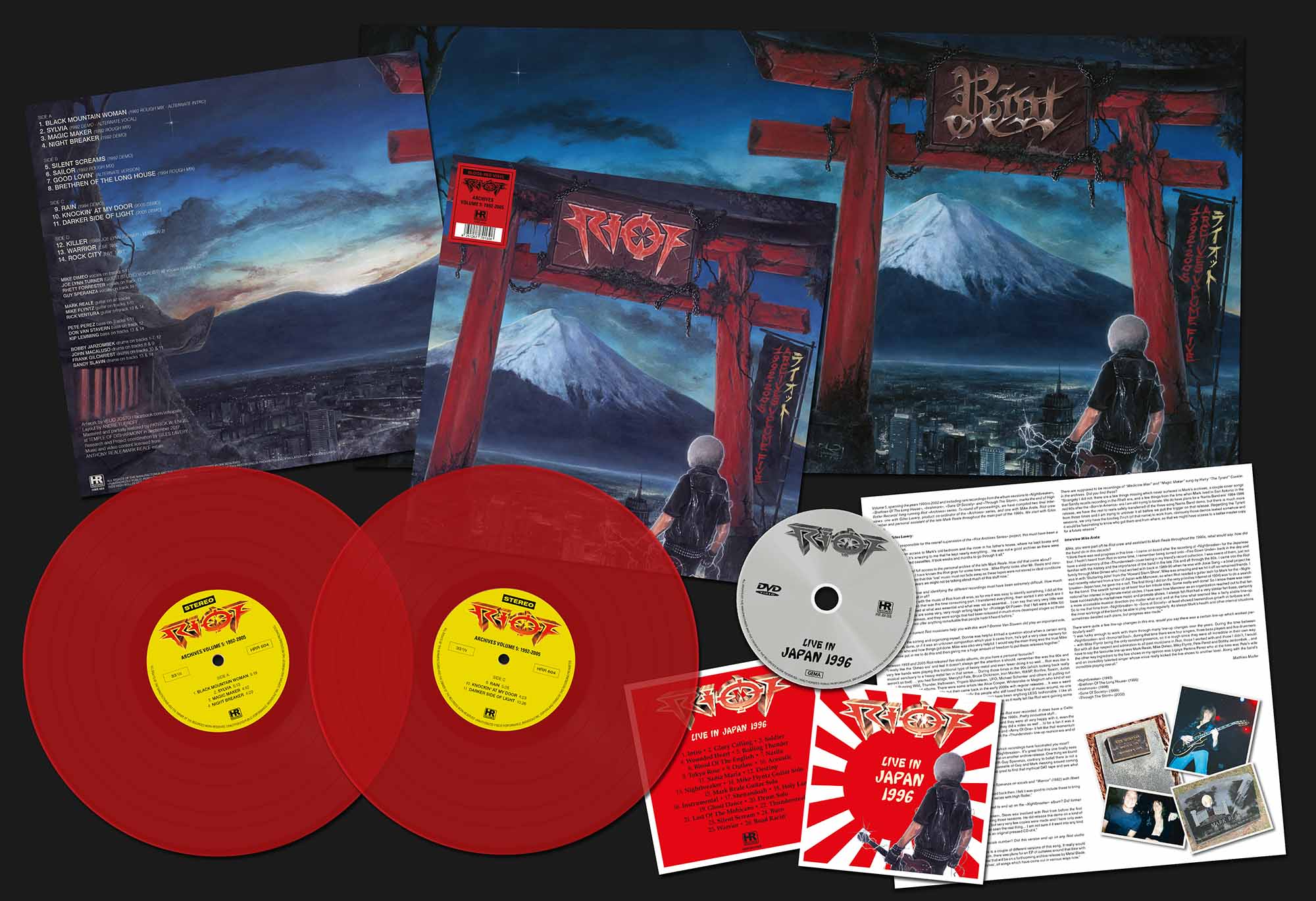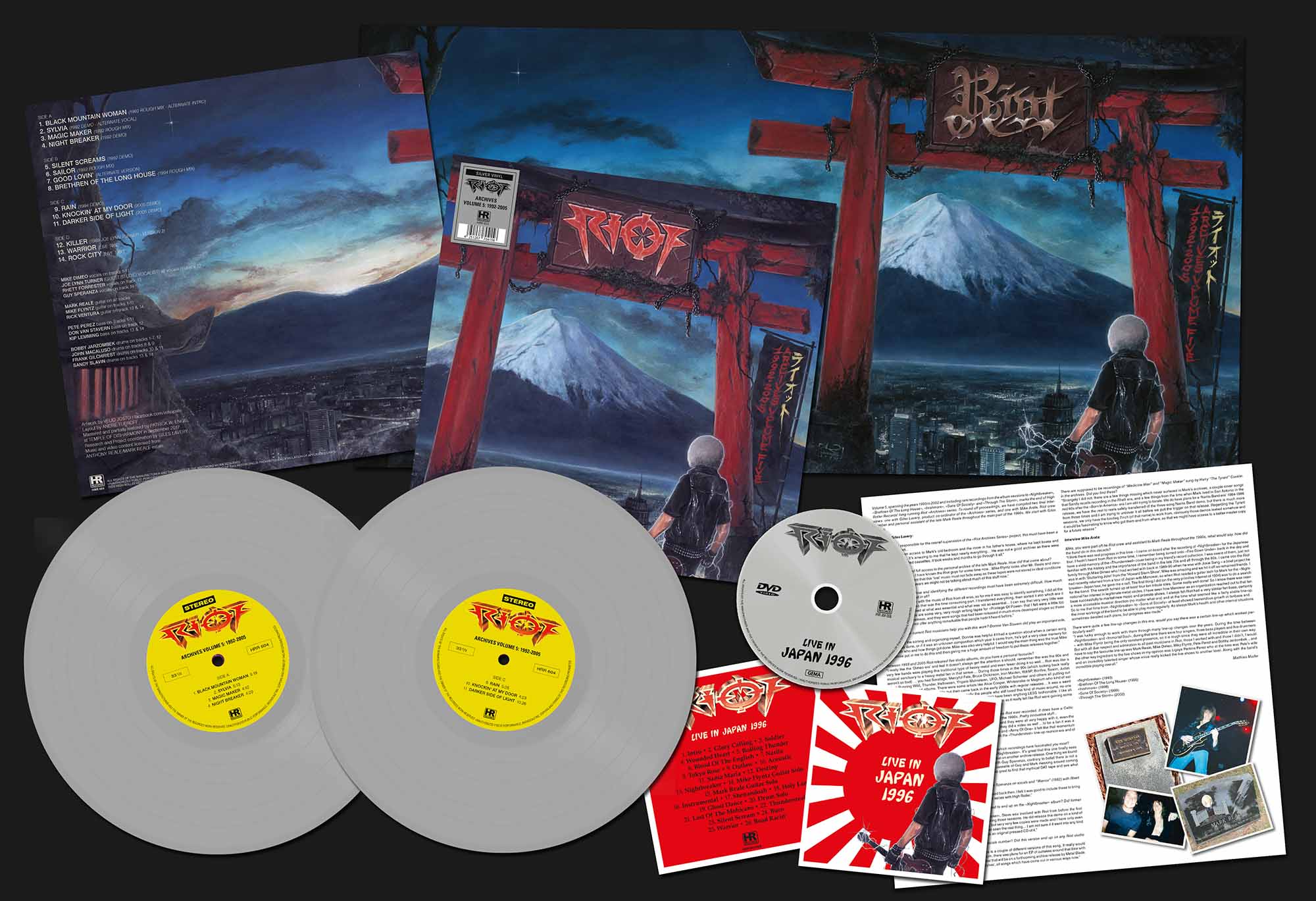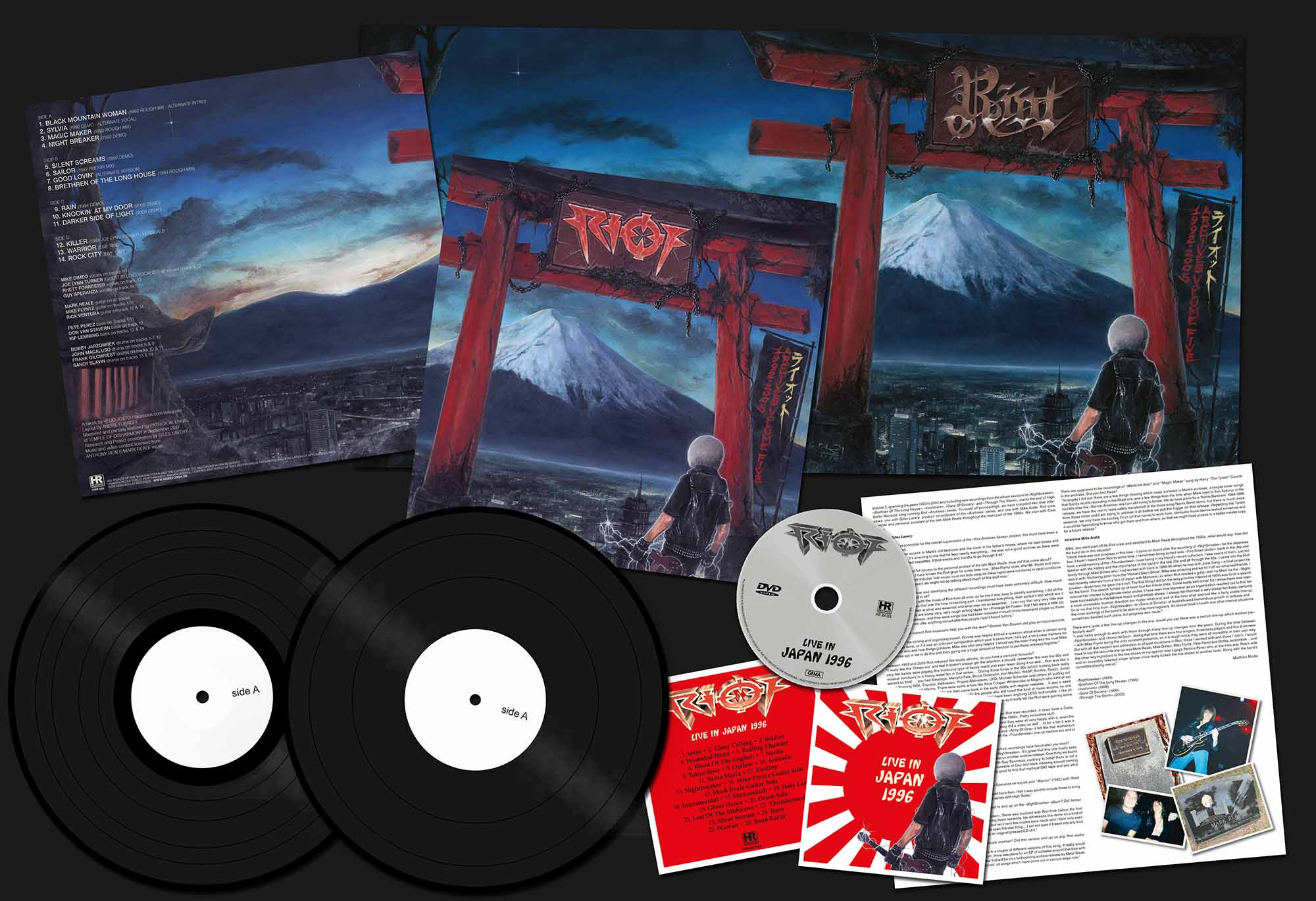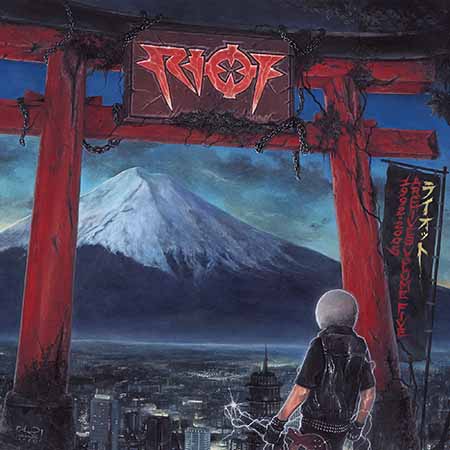 | ||||
| RIOT - Archives Volume 5: 1992-2005 DLP+DVD | |
HRR 604, ltd 600, 100 x silver vinyl (HRR Mailoder exclusive), 300 x transparent blood-red vinyl + 200 x black vinyl, 5mm spine cardboard cover (425gsm), insert, bonus DVD Live in Japan 1996 | |
| 01 Black Mountain Woman (1992 Rough Mix - Alternate Intro) 02 Sylvia (1992 Demo - Alternate Vocal) 03 Magic Maker (1992 Rough Mix) 04 Night Breaker (1992 Demo) 05 Silent Screams (1992 Demo) 06 Sailor (1992 Rough Mix) 07 Good Lovin' (ALternate Version) 08 Brethren of the Long House (1994 Rough Mix) 09 Rain (1994 Demo) 10 Knockin' at My Door (2005 Demo) 11 Darker Side Of Light (2005 Demo) 12 Killer (1989 Joe Lynn Turner - Version 2) 13 Warrior (Live 1982) 14 Rock City (Live 1980) | |
| black vinyl SOLD OUT! red and silver vinyl: LAST COPIES! | |
Volume 5, spanning the years 1993 to 2002 and including rare recordings from the album sessions to »Nightbreaker«, »Brethren Of The Long House«, »Inishmore«, »Sons Of Society« and »Through The Storm«, marks the end of High Roller Records’ long-running Riot »Archives« series. To round off proceedings, we have compiled two final interviews: one with Giles Lavery, product co-ordinator of the »Archives« series, and one with Mike Arata, Riot crew member and personal assistant of the late Mark Reale throughout the main part of the 1990s. We start with Giles Lavery.
Interview Giles Lavery:
You have been responsible for the overall supervision of the »Riot Archives Series« project, this must have been a hell of a lot of work...
“It was, I was given access to Mark’s old bedroom and the room in his father’s house, where he kept boxes and boxes of cassettes. It’s amazing to me that he kept nearly everything… He was not a good archiver as there were hundreds of unlabelled cassettes, it took weeks and months to go through it all.”
As mentioned, you had full access to the personal archive of the late Mark Reale. How did that come about?
“I did have full access. I have known the Riot guys for some time now…Mike Flyntz looks after Mr. Reale and introduced me, I was insistent that this ‘lost’ music must not fade away as these tapes were not stored in ideal conditions and another five or so years we might not be talking about much of this stuff now.”
Going through the archive and identifying the different recordings must have been extremely difficult. How much time did that take you all in all?
“I am very very familiar with the music of Riot from all eras, so for me it was easy to identify something, I did all the tape transfers myself so that was the time consuming part. I transferred everything, then sorted it into which era it belonged to, then looked at what was essential and what was not so essential… I can say that very very little was left unreleased. There are some very, very rough writing tapes for »Privilege Of Power« that I felt were a little too formative for public release, and they were songs that had been released in much more developed stages so these rough sketches did not offer anything remarkable that people hadn’t heard before.”
Did any former or current Riot musicians help you with this work? Donnie Van Stavern did play an important role, didn’t he?
“I actually did the sorting and organizing myself, Donnie was helpful if I had a question about when a certain song or demo was done, or if it was an unknown composition which year it came from, he’s got a very clear memory for where, with who and how things got done. Mike was also very helpful. I would say the main thing was the trust Mike and Donnie put in me to do this and then giving me a huge amount of freedom to put these releases together.”
Between 1993 and 2005 Riot released five studio albums, do you have a personal favourite?
“I really like the ‘Dimeo era’ and feel it doesn’t always get the attention it should, remember this was the 90s and very few bands were playing this traditional type of heavy metal and even fewer doing it so well… Riot was like a musical sanctuary to a heavy metal fan in that sense…. During those times in the 90s (which looking back really weren’t so bad) … you had Savatage, Mercyful Fate, Bruce Dickinson, Iron Maiden, WASP, Bonfire, Saxon, Judas Priest Running Wild, Thunder, Helloween, Yngwie Malmsteen, UFO, Michael Schenker and others all putting out great or at least good albums. There were some artists like Alice Cooper, Whitesnake or Magnum who kind of sat out or split for most of the later 90s but then came back in the early 2000s with regular releases… It was a weird time but in some ways I really liked that it was really the people who still loved this kind of music around, no one was into metal to be fashionable that’s for sure as there couldn’t have been anything LESS fashionable. I like all the Riot albums of this era but »Inishmore« for me would be my favourite as it really felt like Riot were gaining some momentum again by that time.”
1998’s »Inishmore« was indeed one of the most adventurous albums Riot ever recorded. It does have a Celtic theme, which was quite extraordinary for an American metal band in the 1990s. Pretty innovative stuff...
“Absolutely, Mike told me that Mark really loved making this album and they were all very happy with it, even the B-Sides from the ‘Angel Eyes’ single were really really strong, and they did a video as well …to be a fan it was a great feeling of ‘Riot is rising again’. Sadly by »Through The Storm« and »Army Of One« it felt like that momentum had been lost quite a bit… but then they came back stronger still with the »Thundersteel« line-up reunion era and of course we know the rest of the story from there…”
If you take a closer look at the material on »Riot Archives Vol.5», which recordings have fascinated you most?
“’Sylvia’ was a track that proved quite elusive, an outtake from »Nightbreaker«. It’s great that this one finally sees the light of day, there is another version of it too which is coming out on another archive release. One thing we found which is a bonus feature on this release is the 1994 session with Guy Speranza, contrary to belief there is not a fully formed demo of any song or songs, but a 90 minute DAT cassette of Guy and Mark messing around coming up with ideas and looking at the possibility of a reunion… It was great to find that mythical DAT tape and see what it was all about.”
Where are the live recordings of “Rock City” (1980) with Guy Speranza on vocals and “Warrior” (1982) with Rhett Forrester singing from? Any idea?
“These were B-sides from some early singles the band released back then. I felt it was good to include these to bring things full circle as this is the final »Archives» release in this series with High Roller.”
“Sylvia” is a totally unreleased song, was it really supposed to end up on the »Nightbreaker« album? Did former manager Steve Loeb have anything to do with “Sylvia”?
“Yes, as mentioned above it was recorded for »Nightbreaker«, Steve was involved with Riot from before the first album until 1995, so yes, he would have been present during those sessions. He did release this demo on a kind of bootleg live release called »Osaka +2« in the year 2000, but very very few copies were made and I have only even seen one copy which was a CD-R copy, so I haven’t even seen the real thing… I am not sure if it went into any kind of circulation or not as I have never met anyone who has an original pressed CD of it.”
What about “Good Lovin’”? Is this a cover of the Rascals number? Did this version end up on any Riot studio record?
“No, this has nothing to with The Rascals, again there is a couple of different versions of this song, It really would have been out of character for the »Nightbreaker« album, there was plans for an EP of outtakes around that time with the working title of “Creep” … ‘Creep’ is an instrumental that will be on a forthcoming archive release by Metal Blade. Other tracks were to be ‘Faded Hero’, ‘Sailor’ and ‘Sylvia’, all songs which have come out in various ways now.”
There are supposed to be recordings of “Medicine Man” and “Magic Maker” sung by Harry “The Tyrant” Conklin in the archives. Did you find these?
“Strangely I did not, there are a few things missing which never surfaced in Mark’s archives, a couple cover songs that Sandy recalls recording in the Rhett era, and a few things from the time when Mark lived in San Antonio in the mid 80s after the »Born In America« era I am still trying to locate. We do have plans for a ‘Narita Band era’ 1984-1986 release, we have the reel to reels safely transferred of the three-song Narita Band demo, but there is much more from those times and I am trying to uncover it all before we pull the trigger on that release. Regarding the Tyrant sessions, we only have the bootleg 7inch (of that name) to work from, obviously those demos leaked somehow and it would be fascinating to know who got them and from where, so that we might have access to a better master copy for a future release.”
Interview Mike Arata:
Mike, you were part oft he Riot crew and assistant to Mark Reale throughout the 1990s, what would say, how did the band do in this decade?
“I think there was real progress in this time – I came on board after the recording of »Nightbreaker« for the Japanese tour. I hadn’t heard from Riot in some time, I remember being turned onto »Fire Down Under« back in the day and have a vivid memory of the »Thundersteel« cover being in my friend’s record collection. I was aware of them, just not familiar with the history and the importance of the
band in the late 70s and all through the 80s. I came into the Riot family through Mike Dimeo who I had worked with back in 1989-90 when he was with Josie Sang – a brief project he was in with ‘Stuttering John’ from the ‘Howard Stern Show’. Mike was amazing and we hit it off so remained friends. I had recently returned from a tour of Japan with Manowar, so when Riot needed a guitar tech for
Mark for the »Nightbreaker« Japan tour, he gave me a call. The first thing I did (on the very primitive internet of 1994) was to do a search for the band. The search
turned up at least four fan tribute sites. Some really well done! So I knew there was international fan interest in legitimate metal circles. I have seen how Manowar as an organization reached out to that fan base successfully to market new
music and promote shows. I always felt Riot had a very similar fan base, certainly a more accessible musical direction (no matter what era) and at the time what seemed like a fairly stable line-up. So to me that time from »Nightbreaker« to »Sons of Society« at least showed tremendous growth in fanbase and
the inner workings of the band to be able to play more regularly. As always Mark’s health and other internal situations sometimes derailed such plans, but progress was made.”
There were quite a few line-up changes in this era, would you say there was a certain line-up which worked particularly well?
“I was lucky enough to work with them through many line-up changes over the years. During the time between »Nightbreaker« and »Immortal Soul«, during that time there were four singers, three bass players and five drummers – with Mike Flyntz being the only constant presence, so it is tough since they were all incredible in their own way. But with all due respect and admiration to all past musicians in Riot, those I worked with and those I didn’t, I would have to say the favourite line-up was Mark Reale, Mike Dimeo, Miky Flyntz, Pete Perez and Bobby Jarzombek... and the other key ingredient to the live shows in my opinion was Ligaya Perkins Perez who at the time was Pete’s wife and an incredibly talented singer whose voice really kicked the live shows to another level. Along with the band’s incredible playing overall.”
Matthias Mader
»Nightbreaker« (1993)
»Brethren Of The Long House« (1995)
»Inishmore« (1998)
»Sons Of Society« (1999)
»Through The Storm« (2002)
